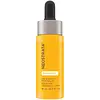What's inside
What's inside
 Key Ingredients
Key Ingredients

 Benefits
Benefits

 Concerns
Concerns

 Ingredients Side-by-side
Ingredients Side-by-side

Propanediol
SolventWater
Skin ConditioningAscorbic Acid
AntioxidantGluconolactone
Skin ConditioningCitric Acid
BufferingEpigallocatechin Gallate
AntioxidantChrysanthemum Parthenium Flower/Leaf/Stem Juice
AntioxidantPentylene Glycol
Skin ConditioningSodium Metabisulfite
AntioxidantSodium Hydroxide
BufferingCaprylyl Glycol
EmollientSodium Benzoate
MaskingPotassium Sorbate
PreservativePhenoxyethanol
PreservativeWater
Skin ConditioningSnail Secretion Filtrate
Skin ConditioningButylene Glycol
HumectantCyclopentasiloxane
EmollientPropanediol
SolventDibutyl Adipate
EmollientPentylene Glycol
Skin ConditioningIsostearyl Isostearate
EmollientSodium Ascorbyl Phosphate
AntioxidantAscorbic Acid
AntioxidantPolyacrylate Crosspolymer-6
Emulsion StabilisingTocopheryl Acetate
AntioxidantDeschampsia Antarctica Leaf Extract
AntioxidantFerulic Acid
AntimicrobialPanthenol
Skin ConditioningSodium Hyaluronate Crosspolymer
HumectantZea Mays Starch
AbsorbentMaltodextrin
AbsorbentDimethicone
EmollientEthylhexylglycerin
Skin ConditioningTrisodium Ethylenediamine Disuccinate
Cetyl Hydroxyethylcellulose
Emulsion StabilisingPolysilicone-11
Decyl Glucoside
CleansingPhenoxyethanol
PreservativeParfum
MaskingWater, Snail Secretion Filtrate, Butylene Glycol, Cyclopentasiloxane, Propanediol, Dibutyl Adipate, Pentylene Glycol, Isostearyl Isostearate, Sodium Ascorbyl Phosphate, Ascorbic Acid, Polyacrylate Crosspolymer-6, Tocopheryl Acetate, Deschampsia Antarctica Leaf Extract, Ferulic Acid, Panthenol, Sodium Hyaluronate Crosspolymer, Zea Mays Starch, Maltodextrin, Dimethicone, Ethylhexylglycerin, Trisodium Ethylenediamine Disuccinate, Cetyl Hydroxyethylcellulose, Polysilicone-11, Decyl Glucoside, Phenoxyethanol, Parfum
Ingredients Explained
These ingredients are found in both products.
Ingredients higher up in an ingredient list are typically present in a larger amount.
Ascorbic Acid is is pure Vitamin C. This form makes up the largest amount of vitamin C found naturally in our skin.
Not only is vitamin C great for your overall health and immune system, it also has plenty of benefits on your skin.
Vitamin C is best used for brightening skin. It improves dark spots, acne scars, and hyperpigmentation. This is because it blocks the process of skin darkening when exposed to UV.
Remember: Vitamin C should not replace sunscreen!
Your skin uses vitamin C to build collagen. Collagen is one key component in having a strong skin barrier and plump skin. Vitamin C also plays a role in regulating collagen, thus making it effective in improving wrinkles and fine lines.
Ascorbic acid shows potent antioxidant activity. As an antioxidant, it helps fight free-radicals. Free-radicals are molecules that may damage your skin cells. These antioxidants also protect skin against UV damage.
The best formulations include Vitamin E and/or ferulic acid. These two ingredients help stabilize and provide a boost in the benefits of ascorbic acid. This is because ascorbic acid becomes unstable when exposed to UV and air. In fact, you can tell your ascorbic acid has oxidized when it turns an orange-yellow color.
Ascorbic acid is generally compatible with other ingredients. However, using ascorbic acid with other active ingredients might cause irritation. Two ingredients: copper ions and benzoyl peroxide, will inactivate ascorbic acid completely.
Read more about other types of Vitamin C:
Foods rich with vitamin C include oranges, strawberries, broccoli, bell peppers, and more. When consuming Vitamin C, your skin receives a portion of the nutrients.
Learn more about Ascorbic AcidPentylene glycol is typically used within a product to thicken it. It also adds a smooth, soft, and moisturizing feel to the product. It is naturally found in plants such as sugar beets.
The hydrophilic trait of Pentylene Glycol makes it a humectant. As a humectant, Pentylene Glycol helps draw moisture from the air to your skin. This can help keep your skin hydrated.
This property also makes Pentylene Glycol a great texture enhancer. It can also help thicken or stabilize a product.
Pentylene Glycol also acts as a mild preservative and helps to keep a product microbe-free.
Some people may experience mild eye and skin irritation from Pentylene Glycol. We always recommend speaking with a professional about using this ingredient in your routine.
Pentylene Glycol has a low molecular weight and is part of the 1,2-glycol family.
Learn more about Pentylene GlycolPhenoxyethanol is a preservative that has germicide, antimicrobial, and aromatic properties. Studies show that phenoxyethanol can prevent microbial growth. By itself, it has a scent that is similar to that of a rose.
It's often used in formulations along with Caprylyl Glycol to preserve the shelf life of products.
Propanediol is an all-star ingredient. It softens, hydrates, and smooths the skin.
It’s often used to:
Propanediol is not likely to cause sensitivity and considered safe to use. It is derived from corn or petroleum with a clear color and no scent.
Learn more about PropanediolWater. It's the most common cosmetic ingredient of all. You'll usually see it at the top of ingredient lists, meaning that it makes up the largest part of the product.
So why is it so popular? Water most often acts as a solvent - this means that it helps dissolve other ingredients into the formulation.
You'll also recognize water as that liquid we all need to stay alive. If you see this, drink a glass of water. Stay hydrated!
Learn more about Water